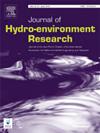管状鱼道有可能让鲑鱼越过高坝逆流而上
IF 2.3
3区 环境科学与生态学
Q2 ENGINEERING, CIVIL
引用次数: 0
摘要
水坝造成的河流破碎破坏了淡水鱼的洄游,这是国际淡水鱼种群数量下降的主要因素。高水坝(20米)可以消除上游鱼类进入广泛的上游水道网络,大大减少了本地物种的栖息地。恢复上游经过高坝的鱼类通道被证明是极其困难和昂贵的。此外,传统鱼道的一个主要弱点是它们是围绕特定尺寸和游泳能力的鱼设计的。管状鱼道的开发是为了恢复鱼类群落在高结构上的上游通道,最初的工作重点是游泳速度较慢的物种。斯拉蒂克(1970)对成熟的上游洄游奇努克鲑鱼(Oncorhynchus tshawytscha)、红鲑鱼(O. nerka)、Coho salmon (O. kisutch)和Steelhead(即Rainbow) trout (O. mykiss)的研究进行了重新处理,以证明它们对管道的强烈吸引力。对数正态形式合理地表示了他的入口时间分布。超过一半的观察鱼在48秒内进入直径0.6米的水平管和直径0.9米的入口锥。这些结果对管道式鱼道在濒危大型鲑科鱼类中的应用具有重要意义。扩展斯拉蒂克的工作,这一贡献量化了大型奇努克鲑鱼的潜在上游通过率,基于一个具有代表性的哥伦比亚河高坝的概念性管状鱼道设计。管形鱼道性能的预测与目前在哥伦比亚系统上使用的传统鱼道相比较有利。因此,管状鱼道提供了改善上游通道和本地鱼类进入国际上广泛的集水区的前景,包括鲑科和非鲑科物种。本文章由计算机程序翻译,如有差异,请以英文原文为准。
Potential for tube fishways to pass salmon upstream over high dams
Disrupted freshwater fish migrations following river fragmentation by dams has been a major factor in internationally declining freshwater fish populations. High dams (>20 m) can eliminate upstream fish passage into extensive upper waterway networks, significantly reducing the habitats available to native species. Restoring upstream fish passage past high dams has proved extremely difficult and costly. Further, a major weakness of conventional fishways has been their design around fish of particular size and swimming ability. The tube fishway was developed with the overarching ambitions of restoring upstream passage for fish communities over high structures, with initial work focussed on slower-swimming species. Slatick’s (1970) studies of mature, upstream migrating Chinook salmon (Oncorhynchus tshawytscha), Sockeye salmon (O. nerka), Coho salmon (O. kisutch), and Steelhead (i.e. Rainbow) trout (O. mykiss) are reprocessed to demonstrate strong attraction into pipes. Log-normal forms reasonably represent his entrance-time distributions. More than half of the observed fish entered 0.6 m diameter horizontal pipes and 0.9 m entrance cones within 48 s. These results have significant implications for the application of tube fishways for endangered large salmonids. Extending Slatick’s work, this contribution quantifies potential upstream passage rates for large Chinook salmon based on a conceptual tube fishway design for a representative high Columbia River dam. Projections of tube fishway performance compare favourably with conventional fishways presently used on the Columbia system. Thereby, the tube fishway offers prospect of improved restoration of upstream passage and native fish access to extensive regions of catchments internationally that embrace both salmonid and non-salmonid species.
求助全文
通过发布文献求助,成功后即可免费获取论文全文。
去求助
来源期刊

Journal of Hydro-environment Research
ENGINEERING, CIVIL-ENVIRONMENTAL SCIENCES
CiteScore
5.80
自引率
0.00%
发文量
34
审稿时长
98 days
期刊介绍:
The journal aims to provide an international platform for the dissemination of research and engineering applications related to water and hydraulic problems in the Asia-Pacific region. The journal provides a wide distribution at affordable subscription rate, as well as a rapid reviewing and publication time. The journal particularly encourages papers from young researchers.
Papers that require extensive language editing, qualify for editorial assistance with American Journal Experts, a Language Editing Company that Elsevier recommends. Authors submitting to this journal are entitled to a 10% discount.
 求助内容:
求助内容: 应助结果提醒方式:
应助结果提醒方式:


